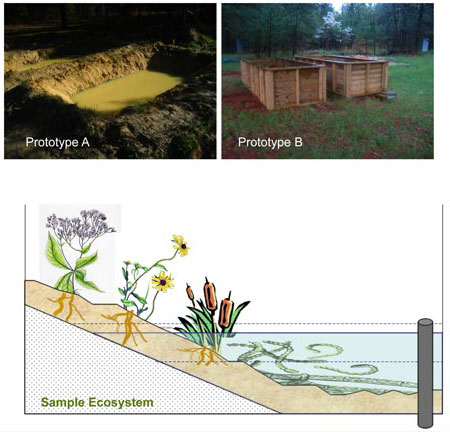| Nov 25, 2010 |
Ecosystem experiments to assess the environmental impact of nanoparticles
|
|
(Nanowerk News) Deep inside Duke Forest, 32 alternate universes sit in quiet rows. They look identical - each with a puddle, some land, a few plants.
|
|
But wholly imperceptible to the naked eye, these plots have distinct and important differences.
|
|
The realms, known as mesocosms, house individual types of nanoparticles as part of a research effort conducted by the Center for the Environmental Implications of Nano Technology (CEINT) based at Duke University.
|
 |
| Mesocosm construction at CEINT.
|
|
CEINT uses laboratory and ecosystem experiments to determine how both natural and man-made nanoparticles - substances that are 1/10,000 the diameter of a human hair - affect the environment.
|
|
Nanotechnology has been a burgeoning field for nearly a decade, but very little research exists about how the tiny particles add up to affect our surroundings.
|
|
Identifying any changes is important, said Mark Wiesner, CEINT director and a Duke civil and environmental engineering professor, because more than 90 percent of some nanoparticles migrate up the food chain to humans.
|
|
"Nanotechnology and nanoparticles have given us huge benefits in medicine, applied mechanics, biotechnology and energy," Wiesner said. "The question is what do we need to avoid so we don't create environmental problems?"
|
|
The 2011 federal budget allots nearly $1.8 billion to nanotechnology research through the National Nanotechnology Initiative, and many investigations are being undertaken in North Carolina.
|
|
According to a 2009 Project on Emerging Nanotechnologies survey, the Research Triangle Park area has the fourth-highest concentration of nanotechnology companies, universities and research laboratories of all metropolitan areas nationwide, and North Carolina ranks in the top 10 states for nanotechnology activities.
|
|
Those analyses include the area's research into the nanotechnology-environment relationship.
|
|
The nanoparticle trail
|
|
To track where and at what levels the environment absorbs nanoparticles, CEINT began the yearlong mesocosm project in August. The findings will also reveal the effects of nanoparticle presence.
|
|
Each waist-high, 3-foot-by-12-foot box contains nanoparticles coated with a different substance, such as titanium dioxide or silver. By following the coating's trail through the mesocosm, Wiesner said, researchers can pinpoint how the nanoparticles either positively or negatively alter their surroundings and at what levels they might become toxic.
|
|
For example, nanosilver has anti-microbial properties and could be a powerful disinfectant. But if high concentrations of the particles wipe out all surrounding bacteria and viruses - even those that may be benign or beneficial - the effects on plants and animals is unknown.
|
|
The Duke investigators are monitoring the mesocosm changes as nanosilver and other nanoparticle levels increase, hoping to identify which substances are most harmful to the environment and humans, and at what level they become worrisome.
|
|
"Nanotechnology is a double-edged sword. Having and using particles this small can be useful, but on the other hand, it presents potential hazards," Wiesner said. "A knife can cut your meals, but you can cut yourself with it, too."
|
|
To better understand the implications of increased nanoparticle use, CEINT recently became home to the Transatlantic Initiative for Nanotechnology and the Environment. This international, $4 million safety program, sponsored by the U.S. Environmental Protection Agency and the United Kingdom Environmental Nanoscience Initiative, will determine how manufactured nanomaterials affect and behave in the environment.
|
|
Nanoparticles in the air
|
|
While many nanoparticles seep through soil, the fastest way for them to spread is through the air. But judging the effect of airborne nanoparticles is difficult because they travel long distances and deposit on surfaces in different concentrations, said Michele Ostraat, director of the Center for Aerosol Technology at RTI International.
|
|
"Aerosols play a large part in the environmental implications of nanotechnology," Ostraat said. "The effects are wide-ranging because the nanoparticles become attached to leaves, rocks and roads, and sometimes are quickly put back into the air."
|
|
Ostraat's office has three projects to research how nanoparticles influence the air. Through miniaturized technology, RTI developed a personal exposure monitor that collects samples of substances in the air before, during and after a person has an asthma attack and identifies it as either naturally occurring or a synthetic aerosol. The data helps determine the levels at which nanoparticles pose an increased pulmonary or cardiovascular risk.
|
|
RTI also uses lightweight nanofibers to design more effective respirator filters. It's easier for wearers, including firefighters, to breathe through the filters made with nanofiber weave, which is smaller than the diameter of most pollutants.
|
|
The organization's latest initiative, Ostraat said, is a nanomaterial registry program that will compile details about the biological and environmental implications of individual nanoparticles in a single database.
|
|
"There's so much information that it's difficult to find a consensus about whether a nanomaterial is toxic," she said. "By putting all of the biological and environmental details together, we can give researchers the extra information they need to make decisions about the particular nanoparticle they face."
|
|
Researchers are making headway in understanding nanoparticles, but the environmental impacts are complex and will require deeper investigations, said toxicologist Nigel Walker, deputy program director for science at the National Toxicology Program in the National Institute of Environmental Health Sciences.
|
|
"This will be a challenge, and it will be a long time before we come to a final resolution of whether nanoparticles are safe or unsafe," Walker said.
|

